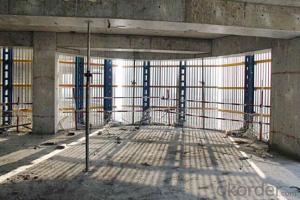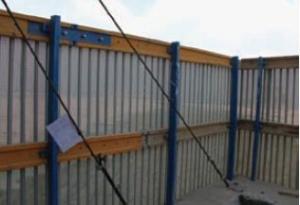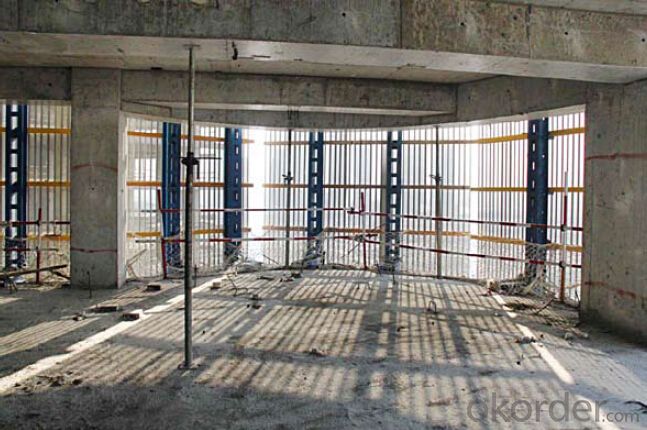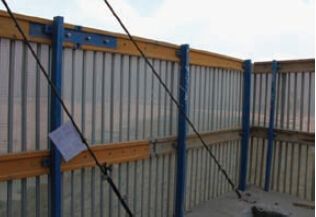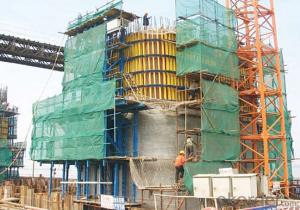Protection-Platform for Formwork and scaffolding system
- Loading Port:
- Tianjin
- Payment Terms:
- TT OR LC
- Min Order Qty:
- 50 m²
- Supply Capability:
- 1000 m²/month
OKorder Service Pledge
OKorder Financial Service
You Might Also Like
Protection Platform PP-50
A kind of new type construction protection system, applying operating platform and safer job
location for construction corps.
Characteristics:
◆ Easy and quick assembling.
◆ Lifted as a group, it is rapid and economic.
◆ Auto-climbing
◆ A safe and reliable anchor system
1. Composition
2. Assembly process of anchor system
(1) Embed V-climbing cone and anchor plate into the slab.
(2) Fix anchor shoe on the slab by tensile bolt.
(3) The fixed anchor shoe.
◆ High work efficiency with work platform and unload platform
◆ High light transmittance with the hollow block


- Q: How does steel formwork affect the overall project cost estimation?
- The overall project cost estimation can be significantly influenced by the use of steel formwork. Although steel formwork may have a higher initial cost when compared to materials like timber or plywood, it offers several advantages that can lead to long-term cost savings. To begin with, steel formwork is extremely durable and can be used multiple times. Unlike timber or plywood formwork that may require replacement after a few uses, steel formwork can withstand numerous cycles, reducing the need for frequent replacements. This not only saves on material costs but also reduces the labor and time required for formwork installation and removal. Moreover, steel formwork provides superior quality finishes, resulting in a decreased need for surface treatments or plastering. This saves both material and labor costs associated with finishing work. Furthermore, steel formwork offers greater precision and dimensional accuracy, reducing the need for rework or adjustments during construction. This helps minimize material wastage and saves time and labor costs. In addition, steel formwork is highly resistant to moisture and weathering, allowing it to be used in various weather conditions without compromising its structural integrity. This flexibility enables more efficient construction scheduling, reducing downtime and potential cost overruns. Lastly, steel formwork can support greater concrete pouring heights and pressures, enabling faster construction and increased productivity. This can result in accelerated project timelines and reduced labor costs. In conclusion, while steel formwork may have a higher initial cost, its durability, reusability, improved finishes, precision, resistance to weathering, and ability to support larger concrete pours can lead to significant cost savings in terms of material, labor, and time. Therefore, steel formwork has a positive impact on the overall project cost estimation.
- Q: What are the maintenance requirements for steel formwork?
- The maintenance requirements for steel formwork primarily involve regular cleaning and inspection. Firstly, it is essential to clean the steel formwork after each use to remove any concrete residue, dirt, or debris. This can be done by using water and a mild detergent, or alternatively, a high-pressure washer can be used for more stubborn stains. Additionally, it is crucial to inspect the steel formwork for any signs of wear, damage, or corrosion. This should be done before and after each use to ensure its structural integrity. Any rust or corrosion spots should be treated promptly by cleaning, sanding, and applying a rust inhibitor or paint to prevent further deterioration. Furthermore, the joints, connections, and fasteners of the steel formwork should be regularly checked to ensure tightness and proper functioning. Loose or damaged parts should be repaired or replaced as necessary. Storage is another important aspect of maintenance. Steel formwork should be stored in a dry and well-ventilated area to prevent rusting and corrosion. It is advisable to stack the formwork properly, with adequate spacing between each piece to prevent deformation and facilitate air circulation. Lastly, it is essential to follow the manufacturer's instructions and recommendations for maintenance and care. This includes using the formwork within its load-bearing capacity, avoiding excessive impact or rough handling, and adhering to any specific maintenance guidelines provided. By following these maintenance requirements, steel formwork can be kept in optimal condition, ensuring its durability, reliability, and longevity for future construction projects.
- Q: Can steel formwork be used in hotel or hospitality construction projects?
- Yes, steel formwork can be used in hotel or hospitality construction projects. Steel formwork offers several advantages over other types of formwork, such as wood or concrete. Firstly, steel formwork is highly durable and can withstand the heavy loads and pressures associated with construction projects. This makes it suitable for use in the construction of hotels, which often require large and complex structures. Secondly, steel formwork is reusable, which can result in cost savings and reduced construction time. This is particularly beneficial for hotel or hospitality construction projects, where the construction process needs to be efficient and timely. Additionally, steel formwork provides a smooth and high-quality finish to concrete surfaces, which is important in the hotel and hospitality industry where aesthetics play a significant role. The smooth finish of steel formwork can enhance the overall appearance of the hotel, creating a more visually appealing and luxurious environment for guests. Furthermore, steel formwork allows for greater flexibility in design, as it can be easily shaped and adjusted to meet specific project requirements. This is advantageous in hotel or hospitality construction projects, where unique and customized designs are often desired to create a distinctive and memorable guest experience. In conclusion, steel formwork can indeed be used in hotel or hospitality construction projects due to its durability, reusability, ability to provide a smooth finish, and flexibility in design.
- Q: Are there any limitations to using steel formwork?
- There are indeed limitations to the use of steel formwork. Initially, steel formwork proves to be relatively costly in comparison to alternative materials such as wood or plastic. Consequently, this can result in it being less cost-effective for smaller or budget-constrained projects. Furthermore, the weight of steel formwork necessitates the use of heavy lifting equipment during installation and removal. This presents a challenge in areas with restricted access or where cranes and other heavy machinery may not be readily accessible. Moreover, skilled labor is required for the proper installation and dismantling of steel formwork. It is imperative to employ experienced workers who possess familiarity with the utilization of steel formwork to ensure the system's safety and effectiveness. In addition, if not adequately protected, steel formwork is prone to corrosion. This can be a cause for concern in environments with high humidity or exposure to moisture, thereby necessitating additional maintenance and protective measures. Lastly, steel formwork lacks the flexibility and adaptability of other formwork materials. It may not be suitable for intricate or irregular shapes, and may require more time and effort to customize according to specific project requirements. In conclusion, although steel formwork offers durability and strength, its limitations in terms of cost, weight, labor requirements, susceptibility to corrosion, and flexibility should be taken into consideration when selecting the most suitable formwork system for a particular construction project.
- Q: What are the different edge protection systems available for steel formwork?
- Some of the different edge protection systems available for steel formwork include edge protectors, guardrails, safety nets, and toe boards.
- Q: How does steel formwork contribute to the overall sustainability of a structure?
- Steel formwork contributes to the overall sustainability of a structure in several ways. Firstly, steel is a highly durable material that can withstand extreme weather conditions and resist corrosion. This means that steel formwork can be reused multiple times, reducing the need for new formwork to be manufactured for each construction project. By reducing the demand for new materials, steel formwork helps to conserve natural resources and minimize the environmental impact associated with the extraction and production of new materials. Additionally, steel formwork allows for efficient and precise construction processes. Its strength and rigidity enable it to support heavy loads and provide stability during concrete pouring. This facilitates faster construction time, reducing labor costs and minimizing the use of construction equipment. The efficiency and precision provided by steel formwork contribute to the overall sustainability of a structure by conserving energy and reducing waste. Moreover, steel formwork is a versatile and flexible option that can be easily adjusted or modified to meet changing construction needs. This adaptability allows for the reuse of formwork in different projects, reducing the amount of waste generated. Furthermore, steel formwork can be recycled at the end of its lifespan, contributing to the circular economy by reducing landfill waste and minimizing the environmental impact associated with disposal. Overall, steel formwork promotes sustainability in construction by reducing the need for new materials, conserving energy, minimizing waste, and facilitating efficient construction processes. Its durability, reusability, adaptability, and recyclability make it an environmentally friendly choice that contributes to the long-term sustainability of structures.
- Q: How does steel formwork affect the overall cost of concrete construction?
- Steel formwork can increase the overall cost of concrete construction due to its higher initial investment compared to other formwork materials. However, it offers several advantages such as durability, reusability, and better quality finishes, which can result in cost savings in the long run by reducing the need for frequent replacements and rework. Additionally, steel formwork allows for faster construction and improved productivity, which can offset the initial cost by reducing labor expenses and project timelines.
- Q: Can steel formwork be used for staircases and ramps?
- Yes, steel formwork can be used for staircases and ramps. Steel formwork is a versatile and durable option for creating complex shapes and structures. It provides the necessary strength and stability required to support the weight and loadings associated with staircases and ramps. Additionally, steel formwork can be easily assembled and disassembled, allowing for efficient construction and customization of staircases and ramps. Its flexibility also enables the creation of various designs and sizes to meet specific project requirements. Overall, steel formwork is a suitable choice for constructing staircases and ramps due to its strength, durability, versatility, and ease of use.
- Q: How is steel formwork cleaned and maintained?
- Steel formwork can be cleaned and maintained by removing any concrete residue using a high-pressure water jet or wire brush. After cleaning, it should be inspected for any damages or rust, and if found, repaired or repainted accordingly. Regular lubrication of moving parts and proper storage in a dry environment also helps to extend its lifespan.
- Q: Can steel formwork be used in seismic zones?
- Yes, steel formwork can be used in seismic zones. Steel is a strong and durable material that can withstand the forces and movements caused by seismic activity. It provides stability and structural integrity to the formwork system, ensuring the safety and effectiveness of the construction process in seismic zones.
Send your message to us
Protection-Platform for Formwork and scaffolding system
- Loading Port:
- Tianjin
- Payment Terms:
- TT OR LC
- Min Order Qty:
- 50 m²
- Supply Capability:
- 1000 m²/month
OKorder Service Pledge
OKorder Financial Service
Similar products
Hot products
Hot Searches
Related keywords
